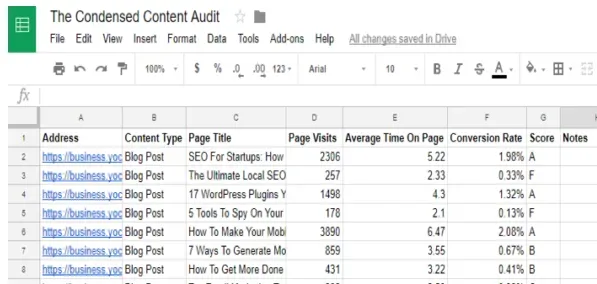In this article, you’ll learn:
You’ve developed a long-term marketing strategy for your brand, set up the copy on your website, and produced months worth of articles.
The problem?
You can’t tell your high-performing content from your mediocre content.
You also can’t tell what’s working and what’s not working. You’re not sure which articles have gotten the most page visits and resulted in the highest conversion rates. And you’re unclear on how users found your content in the first place.
Thankfully, we’re here to help you find a solution to your problem. It’s called a content audit.
In this article, we’ll take a look at what a content audit is and show how you can use one to spruce up your content.
What is a content audit?
A content marketing audit describes the process of gathering and analyzing website assets like articles, landing pages, and blog content.
According to a top SaaS SEO agency, content audit is an honest look at what content performs well, what’s missing, and how you can improve your content and SEO strategy going forward.

With a content audit, you’ll keep an inventory of all your content and notate which assets need updating, deleting, re-writing, or creating.
Similar to a yearly performance review at work, you’ll use the audit to determine whether your content is meeting your business goals — plus how to improve it, so it performs even better.
For instance, take a look at this review of Credit Saint. It was updated after the brand performed a content audit. Notice how it mentions when the piece was last updated in the article?

That’s the result of a content audit.
The importance of setting content audit goals
Having clear content audit goals and metrics can help you make the most of your audit. Without goals to focus on, it’s difficult to gauge what’s working. It also makes the content audit process much more difficult and time-consuming.
To start the goal-setting process, think about the end result. What results do you want to achieve with your content? Are you interested in boosting your SEO scores? Do you want to improve your conversion rates? Do you want to increase audience engagement?
Start with the end of mind, and then set your goals, metrics, and checklist items.
Here’s an example of a goal summary with checklist items and metrics:
Goal 1: Boost SEO presence
- Remove or fix broken links
- Replace weak images with powerful images
- Scan content for updates and removals
- Update SEO to match new SEO rules
- Update facts and stats
- Improve link building
- Check readability scores
- Identify articles with high SEO potential
Metrics to check: backlinks, organic traffic, keyword rankings
How to do a content audit
Before we cover how to conduct a content audit step-by-step, let’s quickly review what the process looks like.
When conducting a content marketing audit, you’ll first catalog all of your existing content assets and related data (i.e., page visits, location, content type, etc.).
Then, you’ll identify the topics that resonate most with your audience. For example, maybe you have a personality quiz that is crushing it on your website like this one:

In instances like these, it’s important to determine what is causing people to resonate with that piece of content more than others, so you can rinse and repeat. In the above example, I’m not saying you have to create more personality quizzes, but a series of content about how certain drinks go with various personality types could be a hit.
Next, you should review if your content is hitting important metrics.
Afterward, you’ll plan out any resources you’ll need and which action items to complete.
For instance, if your audit reveals that your audience spends more time engaging with your Instagram content, you’ll allocate resources to creating more Instagram content.

If your audit reveals that your audience loves listicles like this one on the best productivity apps, you’ll identify which existing articles you can convert into this format. You’ll also identify any new topics you can add to your blog using this format.
In short, conducting a content audit starts with analyzing your existing content to see how it’s helping you achieve your goals. After the analysis, all resources, updates, and new content are planned as part of a fine-tuned content marketing strategy.
How to run an SEO content audit
An SEO content audit follows the same process as a content audit but focuses specifically on SEO.
To run an SEO content audit, you’ll need to catalog your content assets, along with their associated target keywords and metrics.
Here are some examples of targeted metrics you may need to list:
- Backlinks
- Bounce rates
- Conversions
- Traffic sources
- Time spent on page
- Organic keywords
- And other relevant SEO metrics
You’ll also need to note where each post ranks in the search engine results pages (SERPs).
When deciding which metrics to gather and monitor, focus on your specific goals. Are you looking to build backlinks? Then you might focus on tracking metrics like high-authority traffic sources and existing quality backlinks.
Do you want your content to rank in the top-three ranking positions on SERPs? Focus on tracking metrics like organic keywords and topics that rank well.
And speaking of ranking…
SEO content audits also help you understand what you must improve to boost your target keyword rankings.
For instance, your audit may reveal that your SEO content scores are too low. Maybe other competing articles have been posted since you posted yours, and now your scores aren’t competitive enough to rank. This reveals that you need to target more keywords through content to improve content scores.
How to run a content audit step-by-step
Finally, here’s a step-by-step process to help you run your own content audit:
1. Think of your goals
As we’ve mentioned before, your goals determine everything. They determine what metrics you’re going to track. They determine how you’re going to update your content. And they even determine what new content you’ll need to create.
Before doing anything else, take a minute to think about your goals and corresponding metrics. Then, log them into your marketing strategy.
2. Gather your content
Next, gather all of the content assets you’re interested in auditing. This may include blog post content, landing page content, product descriptions, and multimedia. Make sure to gather the entire backlog of that content.
When gathering your backlog, collect URLs of all of the web pages you’re auditing. If gathering the content URLs is easy enough to do manually, you can simply put them in a spreadsheet yourself. If you have a lot of content to sort through, feel free to use a tool like HubSpot or SEMrush to gather URLs for you.
3. Categorize your content
After your URLs are itemized on the spreadsheet, categorize any related data for each URL on the spreadsheet like this:

Remember, the categories you choose will always depend on your goals and allocated metrics.
For instance, if one of your goals is boosting your SEO presence, then your metrics may include:
- Backlinks
- Page visits
- Organic traffic
- Conversion rates
- Keyword rankings
- Content scores
You can also include other categories like publication date, metadata, content format, content type, and author to get a more descriptive view.
When categorizing the information, use a tool like Google Analytics or add the information in yourself.
4. Analyze your data
Now, take a good look at your data to figure out the current state of your content.
When analyzing your data, make sure to note:
- Underperforming content
- High-performing content
- Outdated content that needs to be spruced up
- Content you’re going to remove
- Content your audience would love (but you haven’t covered yet)
Then, add the data as color-coded categories on your spreadsheet.
5. Create action items
In this last step, you’ll assign action items to your spreadsheet so you can finalize and clean up your audit.
Since you’ve already conducted your audit, you now know exactly what to focus on.
For instance, your action items could be:
- Increase audience engagement
- Improve conversion rates
- Create detailed action plans
- Boost SERP ranking
- Build backlinks
To organize your action items, add another column to the spreadsheet close to the front (for easy tracking). This column lets you know what action to take on a specific URL — i.e., keep, delete, refresh, or re-write. You can also rank your action items by priority and include a timeline.
Note: To automate the auditing process, consider using tools like DYNO Mapper, Screaming Frog, and SEMrush. When cleaning up your audit, consider using tools like Writer.com and Grammarly to ensure that you’re using correct grammar.
Bonus tip #1: Don’t forget to check and update your multimedia
Updating your videos, photos, infographics, and other images in your content is just as important as updating your copy.
Here are two examples of companies that update their multimedia regularly:
Bay Alarm Medical uses videos to market products throughout its website.

And Spores.app uses infographics to illustrate SaaS features on its website and landing pages:

Bonus tip #2: Create a website content audit checklist
To conduct your content audit as smoothly as possible, create a checklist that walks you through the entire process.
Here’s an example of a content audit checklist:
Content Audit Checklist
1. Analyze multimedia
2. Do the visuals need to be updated or changed?
3. Plan action items for multimedia
4. Double check all copy
5. Is the writing still on brand?
6. Is the writing updated to match the new tone of voice and updated style guides?
7. Are the facts, stats, and quotes updated?
8. Is the advice or copy out of date?
9. Is it edited and free or errors?
10. Plan action items for copy
11. Double check the SEO strategy for each
12. Note the target keyword and secondary keywords
13. Is the SEO strategy working?
14. How can we improve the SEO strategy?
15. Plan action items for SEO
Ready to run your own content audit?
With the right steps, planned goals, and a checklist to keep you accountable, you’ll be all set to run a successful content audit. Feel free to refer to these seven tips any time you get stuck.
Performing a content audit soon? Tag @pics.io on social media to let us know what you thought of this article.
Need more help? Boost your productivity with Pics.io’s file organization tool.
Author



